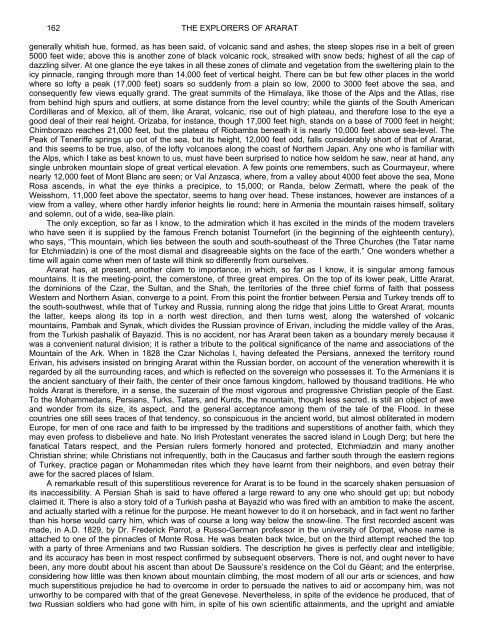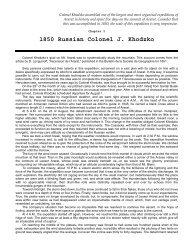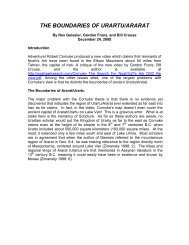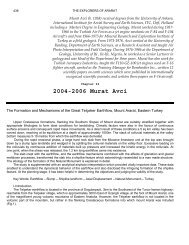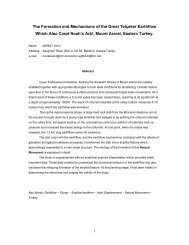1876 British Viscount & Ambassador James Bryce - Noah's Ark Search
1876 British Viscount & Ambassador James Bryce - Noah's Ark Search
1876 British Viscount & Ambassador James Bryce - Noah's Ark Search
Create successful ePaper yourself
Turn your PDF publications into a flip-book with our unique Google optimized e-Paper software.
162 THE EXPLORERS OF ARARAT<br />
generally whitish hue, formed, as has been said, of volcanic sand and ashes, the steep slopes rise in a belt of green<br />
5000 feet wide; above this is another zone of black volcanic rock, streaked with snow beds; highest of all the cap of<br />
dazzling silver. At one glance the eye takes in all these zones of climate and vegetation from the sweltering plain to the<br />
icy pinnacle, ranging through more than 14,000 feet of vertical height. There can be but few other places in the world<br />
where so lofty a peak (17,000 feet) soars so suddenly from a plain so low, 2000 to 3000 feet above the sea, and<br />
consequently few views equally grand. The great summits of the Himalaya, like those of the Alps and the Atlas, rise<br />
from behind high spurs and outliers, at some distance from the level country; while the giants of the South American<br />
Cordilleras and of Mexico, all of them, like Ararat, volcanic, rise out of high plateau, and therefore lose to the eye a<br />
good deal of their real height. Orizaba, for instance, though 17,000 feet high, stands on a base of 7000 feet in height;<br />
Chimborazo reaches 21,000 feet, but the plateau of Riobamba beneath it is nearly 10,000 feet above sea-level. The<br />
Peak of Teneriffe springs up out of the sea, but its height, 12,000 feet odd, falls considerably short of that of Ararat,<br />
and this seems to be true, also, of the lofty volcanoes along the coast of Northern Japan. Any one who is familiar with<br />
the Alps, which I take as best known to us, must have been surprised to notice how seldom he saw, near at hand, any<br />
single unbroken mountain slope of great vertical elevation. A few points one remembers, such as Courmayeur, where<br />
nearly 12,000 feet of Mont Blanc are seen; or Val Anzasca, where, from a valley about 4000 feet above the sea, Mone<br />
Rosa ascends, in what the eye thinks a precipice, to 15,000; or Randa, below Zermatt, where the peak of the<br />
Weisshorn, 11,000 feet above the spectator, seems to hang over head. These instances, however are instances of a<br />
view from a valley, where other hardly inferior heights lie round; here in Armenia the mountain raises himself, solitary<br />
and solemn, out of a wide, sea-like plain.<br />
The only exception, so far as I know, to the admiration which it has excited in the minds of the modern travelers<br />
who have seen it is supplied by the famous French botanist Tournefort (in the beginning of the eighteenth century),<br />
who says, “This mountain, which lies between the south and south-southeast of the Three Churches (the Tatar name<br />
for Etchmiadzin) is one of the most dismal and disagreeable sights on the face of the earth.” One wonders whether a<br />
time will again come when men of taste will think so differently from ourselves.<br />
Ararat has, at present, another claim to importance, in which, so far as I know, it is singular among famous<br />
mountains. It is the meeting-point, the cornerstone, of three great empires. On the top of its lower peak, Little Ararat,<br />
the dominions of the Czar, the Sultan, and the Shah, the territories of the three chief forms of faith that possess<br />
Western and Northern Asian, converge to a point. From this point the frontier between Persia and Turkey trends off to<br />
the south-southwest, while that of Turkey and Russia, running along the ridge that joins Little to Great Ararat, mounts<br />
the latter, keeps along its top in a north west direction, and then turns west, along the watershed of volcanic<br />
mountains, Pambak and Synak, which divides the Russian province of Erivan, including the middle valley of the Aras,<br />
from the Turkish pashalik of Bayazid. This is no accident, nor has Ararat been taken as a boundary merely because it<br />
was a convenient natural division; it is rather a tribute to the political significance of the name and associations of the<br />
Mountain of the <strong>Ark</strong>. When in 1828 the Czar Nicholas I, having defeated the Persians, annexed the territory round<br />
Erivan, his advisers insisted on bringing Ararat within the Russian border, on account of the veneration wherewith it is<br />
regarded by all the surrounding races, and which is reflected on the sovereign who possesses it. To the Armenians it is<br />
the ancient sanctuary of their faith, the center of their once famous kingdom, hallowed by thousand traditions. He who<br />
holds Ararat is therefore, in a sense, the suzerain of the most vigorous and progressive Christian people of the East.<br />
To the Mohammedans, Persians, Turks, Tatars, and Kurds, the mountain, though less sacred, is still an object of awe<br />
and wonder from its size, its aspect, and the general acceptance among them of the tale of the Flood. In these<br />
countries one still sees traces of that tendency, so conspicuous in the ancient world, but almost obliterated in modern<br />
Europe, for men of one race and faith to be impressed by the traditions and superstitions of another faith, which they<br />
may even profess to disbelieve and hate. No Irish Protestant venerates the sacred island in Lough Derg; but here the<br />
fanatical Tatars respect, and the Persian rulers formerly honored and protected, Etchmiadzin and many another<br />
Christian shrine; while Christians not infrequently, both in the Caucasus and farther south through the eastern regions<br />
of Turkey, practice pagan or Mohammedan rites which they have learnt from their neighbors, and even betray their<br />
awe for the sacred places of Islam.<br />
A remarkable result of this superstitious reverence for Ararat is to be found in the scarcely shaken persuasion of<br />
its inaccessibility. A Persian Shah is said to have offered a large reward to any one who should get up; but nobody<br />
claimed it. There is also a story told of a Turkish pasha at Bayazid who was fired with an ambition to make the ascent,<br />
and actually started with a retinue for the purpose. He meant however to do it on horseback, and in fact went no farther<br />
than his horse would carry him, which was of course a long way below the snow-line. The first recorded ascent was<br />
made, in A.D. 1829, by Dr. Frederick Parrot, a Russo-German professor in the university of Dorpat, whose name is<br />
attached to one of the pinnacles of Monte Rosa. He was beaten back twice, but on the third attempt reached the top<br />
with a party of three Armenians and two Russian soldiers. The description he gives is perfectly clear and intelligible;<br />
and its accuracy has been in most respect confirmed by subsequent observers. There is not, and ought never to have<br />
been, any more doubt about his ascent than about De Saussure’s residence on the Col du Géant; and the enterprise,<br />
considering how little was then known about mountain climbing, the most modern of all our arts or sciences, and how<br />
much superstitious prejudice he had to overcome in order to persuade the natives to aid or accompany him, was not<br />
unworthy to be compared with that of the great Genevese. Nevertheless, in spite of the evidence he produced, that of<br />
two Russian soldiers who had gone with him, in spite of his own scientific attainments, and the upright and amiable


